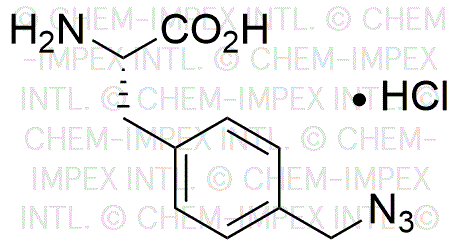4-Azidomethyl-L-phenylalanine hydrochloride is widely utilized in research focused on:
- Bioconjugation: This compound serves as a versatile building block for bioconjugation, allowing researchers to attach biomolecules to surfaces or other molecules, enhancing drug delivery systems.
- Protein Labeling: It is used in the labeling of proteins for visualization in various assays, aiding in the study of protein interactions and functions.
- Drug Development: The compound plays a significant role in the development of novel therapeutics, particularly in creating targeted treatments that can improve efficacy and reduce side effects.
- Click Chemistry: Its azide functional group is ideal for click chemistry applications, facilitating the rapid and selective formation of chemical bonds, which is essential in creating complex molecular structures.
- Research in Neuroscience: This chemical is utilized in neuroscience studies to investigate the role of specific amino acids in neuronal signaling and behavior, contributing to advancements in understanding brain function.
General Information
Properties
Safety and Regulations
Applications
4-Azidomethyl-L-phenylalanine hydrochloride is widely utilized in research focused on:
- Bioconjugation: This compound serves as a versatile building block for bioconjugation, allowing researchers to attach biomolecules to surfaces or other molecules, enhancing drug delivery systems.
- Protein Labeling: It is used in the labeling of proteins for visualization in various assays, aiding in the study of protein interactions and functions.
- Drug Development: The compound plays a significant role in the development of novel therapeutics, particularly in creating targeted treatments that can improve efficacy and reduce side effects.
- Click Chemistry: Its azide functional group is ideal for click chemistry applications, facilitating the rapid and selective formation of chemical bonds, which is essential in creating complex molecular structures.
- Research in Neuroscience: This chemical is utilized in neuroscience studies to investigate the role of specific amino acids in neuronal signaling and behavior, contributing to advancements in understanding brain function.
Documents
Safety Data Sheets (SDS)
The SDS provides comprehensive safety information on handling, storage, and disposal of the product.
Product Specification (PS)
The PS provides a comprehensive breakdown of the product’s properties, including chemical composition, physical state, purity, and storage requirements. It also details acceptable quality ranges and the product's intended applications.
Certificates of Analysis (COA)
Search for Certificates of Analysis (COA) by entering the products Lot Number. Lot and Batch Numbers can be found on a product’s label following the words ‘Lot’ or ‘Batch’.
Numéro de catalogue
Numéro de lot/série
Certificates Of Origin (COO)
This COO confirms the country where the product was manufactured, and also details the materials and components used in it and whether it is derived from natural, synthetic, or other specific sources. This certificate may be required for customs, trade, and regulatory compliance.
Numéro de catalogue
Numéro de lot/série
Safety Data Sheets (SDS)
The SDS provides comprehensive safety information on handling, storage, and disposal of the product.
DownloadProduct Specification (PS)
The PS provides a comprehensive breakdown of the product’s properties, including chemical composition, physical state, purity, and storage requirements. It also details acceptable quality ranges and the product's intended applications.
DownloadCertificates of Analysis (COA)
Search for Certificates of Analysis (COA) by entering the products Lot Number. Lot and Batch Numbers can be found on a product’s label following the words ‘Lot’ or ‘Batch’.
Numéro de catalogue
Numéro de lot/série
Certificates Of Origin (COO)
This COO confirms the country where the product was manufactured, and also details the materials and components used in it and whether it is derived from natural, synthetic, or other specific sources. This certificate may be required for customs, trade, and regulatory compliance.


